2. 环境保护部华南环境科学研究所, 广州 510655
2. South China Institute of Environmental Science, Ministry of Environmental Protection, Guangzhou 510665, China
土壤砷污染主要是由于工业和农业活动使大量的砷进入土壤,并通过食物链使人类摄入过量的砷[1, 2].其中,人类(主要是儿童) 可能会通过一些途径意外摄入土壤和尘埃[3].土壤砷的毒性与砷总量有关,但只有一部分是具有生物可给性,能被动物吸收[4]. in vitro体外模拟法是指活体外模拟肠胃环境中投加一定量的试验物,模拟人体肠胃环境中对某种物质的吸收,主要包括PBET、SBRC和IVG法,能够即时地反映肠胃消化液对土壤砷的溶解和吸收,避免耗时长,耗费较高和可控性差等问题[5, 6].不少研究中都证实相比于in vivo活体内试验,in vitro体外模拟法能准确地评估土壤可给砷的量,Ruby等[7]证实PBET方法提取的生物可给性与活体试验具有很好的相关性. Rodriguez等[8]采用幼猪进行活体实验以及利用IVG体外模拟方法对比研究,表明活体实验砷生物可给性与IVG体外模拟胃和小肠阶段提取的砷都具有显著地相关性(r=0.83,P<0.01;r=0.82,P<0.01). Juhasz等[9]用小猪活体实验证明SBRC法是能够替代体内实验的体外模拟方法.
摄入的土壤砷可以分为5种形态:可交换态(F1)、专性吸附态(F2)、无定型铁矿物结合态(F3)、结晶型铁矿物结合态(F4) 和残渣态(F5) [10].其中,F1和F2的移动性与毒性最高,容易被植物或动物吸收,而F3的移动性和可给性都低得多;F4则等同于砷与高结晶度铁矿物紧紧结合[11].铁矿物被证实是砷最大的吸附运载体,其中水铁矿、针铁矿、赤铁矿等对土壤砷的环境行为有不同的影响[12].施加铁矿物时,有利于稳定化土壤中的砷,降低砷的移动性[12],且铁矿物的老化过程有利于砷更加牢固地嵌入,促使砷被固化[13].铁矿物的结晶度是影响铁矿物对土壤砷形态转换的重要因素[12~14],研究不同结晶度的铁矿物对土壤砷的生物可给性的影响具有重要意义.
本文采用3种in vitro模拟法研究不同铁矿物对土壤砷生物可给性的影响,综合探讨铁矿物的施用在肠胃阶段对砷生物可给性的影响机制,以期为降低人类健康风险提供理论指导和依据.
1 材料与方法 1.1 供试土壤本实验供试土壤采自广西省贺州市老虎山周边砷污染区农田土壤,经自然风干,研磨过100目筛后,以备稳定化处理和in vitro实验.土壤基本理化性质为: pH 6.26;阳离子交换量(CEC) 4.766 cmol·kg-1;有机质(SOM) 12.0 g·kg-1;土壤电导率(EC) 127.3 S·m-1;Cd、Pb、Cu和As总量分别为13.76、353.45、360.63和109.35 mg·kg-1.
1.2 土壤稳定化铁矿物的制备,水铁矿、针铁矿和赤铁矿的制备方法参考文献[15~17],并分别施用1 g和2 g的3种铁矿物于100 g土壤中(1%和2%质量分数)[18, 19],处理编号如表 1.并添加混合料50%(质量分数) 的去离子水,充分搅拌使混合均匀,置于干燥通风处熟化2周后,即研磨过100目筛后备用.
|
|
表 1 处理配方(质量分数)/% Table 1 Formula of stabilization treatment/% |
1.3 in vitro方法
本实验采用PBET、SBRC和IVG这3种in vitro方法研究砷污染土壤砷的生物可给性,其具体参数见表 2.胃和小肠阶段通氩气1 L·min-1处理,温度控制在37℃并在100 r·min-1转速下搅动,每种in vitro方法在胃阶段和肠阶段消化后,并分别取3.0 mL,10 000 r·min-1离心分离,过0.45 μm滤膜,同时在进行肠阶段消化前,添加3.0 mL胃液以补偿采样后的损耗,具体体外胃肠模拟实验操作如图 1.其中,消化液的砷含量采用原子荧光(AFS-52) 测定.
|
|
表 2 3种体外模拟生物可给性方法的主要参数1) Table 2 Main parameters of the three in vitrobioaccessibility simulation methods |
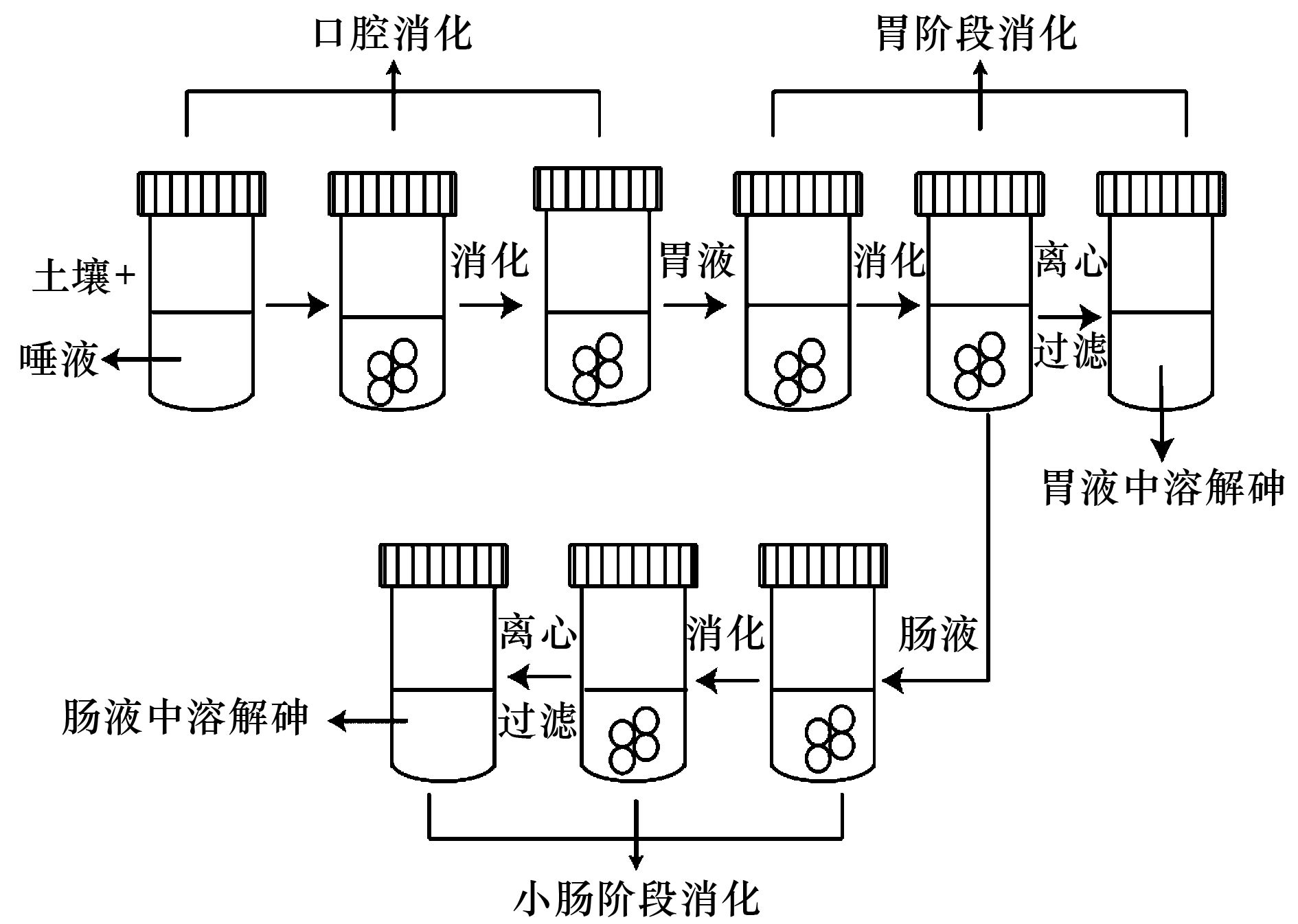
|
口腔消化不做砷的生物可给性探讨,主要针对胃和小肠阶段的研究 图 1 体外胃肠模拟实验流程示意 Fig. 1 Flow chart of thein vitroGastrointestinal simulation test |
土壤砷形态提取采用改进的Wenzel连续提取法[22],其中砷的可交换态利用土壤/提取液[0.05 mol·L-1(NH4)2SO4溶液]为1:30(g·mL-1) 的比例提取,室温下振荡2 h,且重复提取两次;专属吸附态砷采用1:25(g·mL-1) 的土壤/提取液(0.05 mol·L-1 NH4H2PO4) 室温下提取12 h;无定型结合态砷采用0.2 mol·L-1 (NH4)2C2O4/H2C2O4溶液(pH=3.0) 在室温黑暗条件下振荡4 h.
土壤pH采用0.01 mol·L-1 CaCl2溶液(土:液=1:2.5) 提取并使用pH计测定;土壤电导率利用电导率仪测定土壤悬液,其中土壤:去离子水为1:5 (g·mL-1);土壤阳离子交换量(CEC) 采用BaCl2置换法;土壤有机质采用重铬酸钾外加热法测定.土壤重金属Pb、Cd、Cu和As总量使用王水微波消解,消解完成后,添加1 mL HF进行赶酸. Pb、Cd和Cu含量采用ICP-OES (Agilent, 710) 测定,As利用原子荧光测定(AFS-52).
1.5 土壤砷的生物可给性计算胃阶段和小肠阶段砷的生物可给性可表示为:
BA=(civ×Viv)/(Ts×Ms)×100%
式中,civ是in vitro实验胃阶段或者小肠阶段消化液中砷的可溶态总量,μg·L-1;Viv为反应器中反应液的体积,L;Ts是土壤样品砷的总量,mg·kg-1;Ms为加入反应器中的土壤样品的质量,kg.
1.6 数据分析实验结果用SPSS 19.0统计分析软件进行分析;实验作图采用Origin 8.1软件.
2 结果与讨论 2.1 胃阶段砷的生物可给性如图 2所示,按照PBET、SBRC和IVG这3种in vitro体外模拟方法,空白土壤(CK) 在胃液中有最大的砷溶解度,此时,胃阶段砷的生物可给性分别为2.70%、6.68%和13.33%;而施用不同铁矿物对土壤砷在胃阶段的生物可给性产生了影响,其中施用1%水铁矿处理组(F1),相比于CK处理组在胃阶段的砷生物可给性显著降低(P<0.05),其胃阶段砷的生物可给性依次为2.22%、5.11%和7.43%;且当施用量提高到2%时(F2处理组),胃阶段砷的生物可给性进一步下降(P<0.05),降幅分别为0.84%、3.0%和9.16%.这可能与水铁矿具有最大的比表面积、表面活性高和相应地吸附性能有关[23].添加1%针铁矿时,与空白土壤相比,只有SBRC和IVG方法中表现为胃消化阶段砷的生物可给性显著下降(P<0.05),其中IVG法最为显著,最大降幅为3.29%;提高针铁矿投加量到2%时,砷的生物可给性都显著降低(P<0.05),此时,根据PBET、SBRC和IVG这3种in vitro方法依次为2.29%、5.49%和8.64%.这可能与针铁矿处于亚稳态,表面具有较多的羟基基团有关,一般而言,能与土壤有效态砷发生配位体交换而将砷吸持,而即使在胃液pH较低的条件下,被吸持的砷不容易释放[24].相比于水铁矿和针铁矿,赤铁矿则对胃阶段砷的生物可给性降低幅度较少,如H1相比F1和G1都具有较高的砷生物可给性,相同的结果同样出现在H2、F2和G2.这与赤铁矿的结构最稳定,且相比于水铁矿和针铁矿具有较高的结晶度和较低的比表面积有关[25].相似地,Cutler等[26]往砷污染土壤中加入FeCl3/FeSO4和石灰,发现两年后采用体外模拟方法测试了土壤砷的生物可给性,降低了63%,且进一步研究证实这与铁矿物的形成而进一步影响砷的化学行为有关.且3种in vitro模拟方法中,相同处理在胃阶段砷的生物可给性不同,如F1处理中胃阶段砷生物可给性为BAPBET<BASBRC<BAIVG,这可能与胃阶段胃液的pH条件和胃液中物质组成不同有关,相比于PBET方法,IVG和SBRC模拟方法的胃液中具有相对较低的pH值,且较低pH条件下将有利于砷在胃液中溶解,其中部分无定型铁结合态砷发生溶解,导致砷失去吸附点位而溶解释放,从而提高胃液中的溶解态砷有关[9].
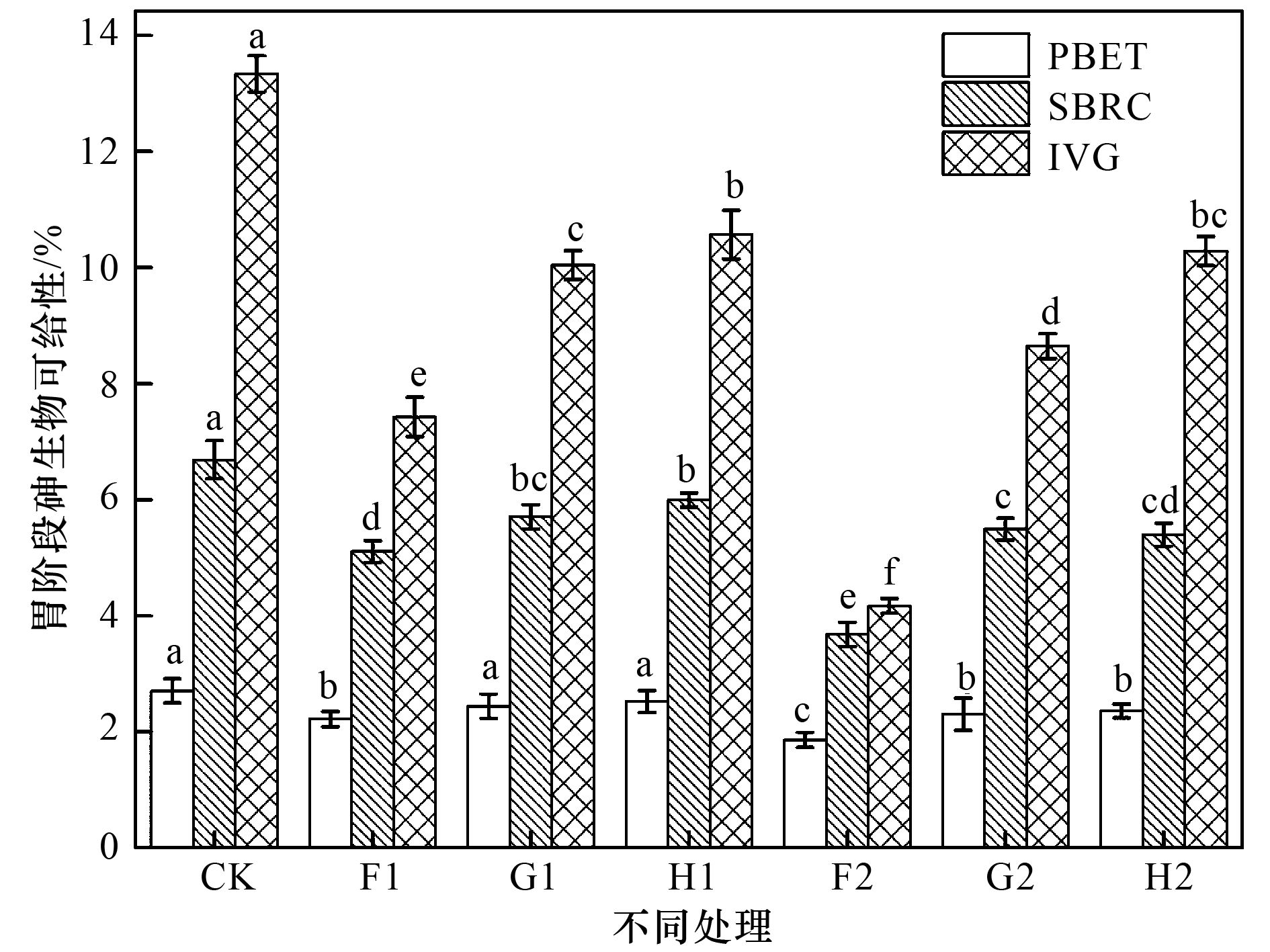
|
同一种in vitro方法中不同字母的表示有差异(P<0.05) 图 2 施用不同铁矿物对土壤砷的胃阶段生物可给性影响 Fig. 2 Effect of the application of different iron minerals on arsenic bioaccessibility in the gastric phase |
由图 3可知,空白对照组(CK) 在小肠阶段具有最高的砷生物可给性,按照PBET、SBRC和IVG这3种in vitro体外模拟方法,其大小分别为4.05%、5.84%和8.84%. 3种铁矿物在投加量相同条件下,依据PBET和IVG方法,都表现为赤铁矿、针铁矿和水铁矿处理组在小肠阶段砷生物可给性依次降低,如BAH1<BAG1<BAF1(BAH2<BAG2<BAF2),此时,按照PBET方法小肠阶段砷的生物可给性依次为3.83%、3.65%和3.39%,按照IVG方法则分别为7.48%、7.40%和6.18%.且3种in vitro方法中,只有水铁矿处理组的砷生物可给性相比于空白土壤(CK) 都显著下降(P<0.05),这可能与小肠消化液有关与铁矿物的对砷的稳定化效果有关[19],小肠消化液pH值较高时(7.0或5.5),能促进二次铁矿物的生成,且砷能够和水铁矿发生配位体交换而对砷具有较好的稳定化效果[27],这也说明3种铁矿物对砷的吸持稳定性不同.根据SBRC和IVG体外模拟方法,任何处理组都表现出胃阶段砷的生物可给性大于小肠阶段砷生物可给性,如F1处理组,这与崔岩山等[28]的研究一致,表现为小肠阶段的消化液具有更低的溶解态砷.从胃阶段到小肠消化阶段, 消化液pH从1.5升高到7.0(SBRC模拟法) 或者1.8升高到5.5(IVG模拟法),在较高的pH条件下将有利于铁氧化物的生成,促进对溶解态砷的吸附共沉淀,因而消化液相比于胃液的溶解态砷浓度更低[29]. Juhasz等[30]研究表明,胃液到小肠消化液中的Fe2+浓度降低,这表明小肠消化阶段的部分Fe2+可能被氧化促使砷被吸附共沉淀. Liu等[31]通过in vivo动物实验进一步证实铁氧化物通过对砷的吸附而降低砷的有效性和毒性.相反,PBET法则表现为胃阶段的砷生物可给性小于小肠阶段的砷生物可给性,可能与胃液的物质组成以及从胃液到小肠消化液的pH值变化二者有关,这与Juhasz等[9]的研究一致.
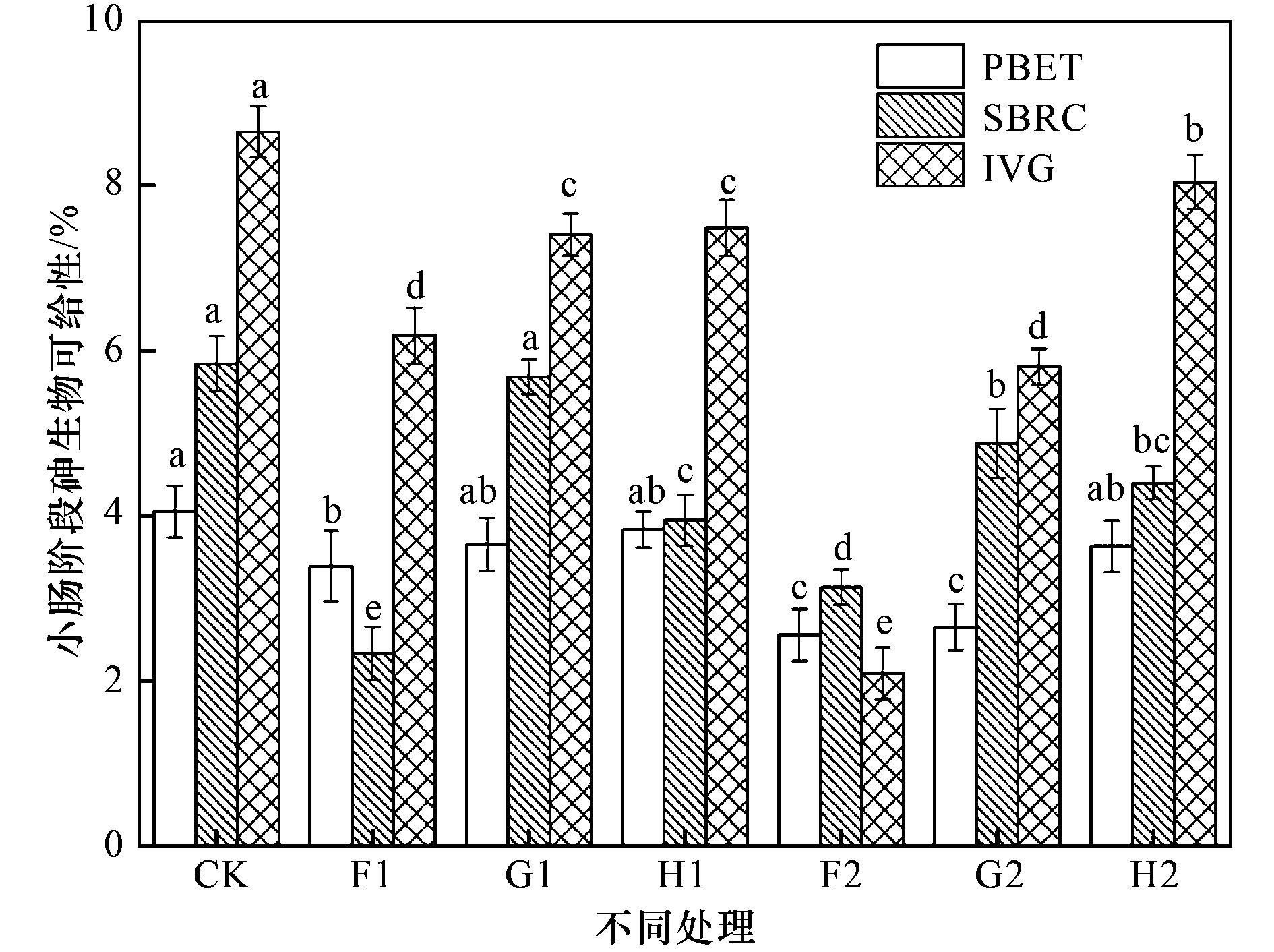
|
同一种in vitro方法中不同字母的表示有差异(P<0.05) 图 3 施用不同铁矿物对土壤砷的小肠阶段生物可给性影响 Fig. 3 Effect of the application of different iron minerals on arsenic bioaccessibility in the small intestinal phase |
由图 4可知,胃阶段砷的生物可给性与可交换态砷和专性吸附态砷的总量(F1+F2) 呈正相关关系,相关系数按PBET、SRBC和IVG这3种in vitro方法依次为r=0.93(P<0.01)、r=0.90(P<0.01) 和r=0.89(P<0.01).而小肠阶段砷的生物可给性与可交换态和专属吸附态砷总量有显著正相关关系,主要为PBET和IVG模拟法,相关性分别为r=0.94,P=0.001和r=0.87,P=0.009.这说明土壤有效态砷和吸附态砷容易在胃液和小肠消化液释放形成溶解态砷,与砷的生物有效性和专属吸附态砷是土壤砷形态最易被提取呈一致性[32].这也表明可交换态和专属吸附态砷对胃和小肠阶段土壤砷的溶解贡献较大. Im等[33]研究同样说明非专性吸附态、专性吸附态砷的生物可给性最大,其次为无定型铁结合态砷,生物可给性最小的是结晶铁结合态和残渣态砷. Li等[6]进一步研究指出,非专性吸附态砷和专性吸附态砷对生物可给性砷的贡献最大,非专性吸附态砷与可给性砷的相关系数为0.42~0.52,而非专性和专性吸附态砷之和与可给性砷的相关系数高达0.55~0.69.因而,相比于空白土壤(CK),施用不同铁矿物处理土壤的可交换态和专属吸附态砷都降低,且在in vitro这3种方法中胃或者小肠阶段砷的生物可给性都减少,这与铁矿物通过与有效态砷和专属吸附态砷螯合形成较为稳定的螯合物,形成无定型结合态和结晶型结合态砷有关[10, 14].且在增大铁矿物的施用量时,可以进一步提高非专性吸附与专性吸附态砷转化为无定型铁矿物结合态或者结晶型铁结合态砷的含量,降低砷的生物有效性和毒性[34],相应地降低了胃和小肠阶段砷的生物可给性.这与Juhasz等[35]用体外模拟法研究砷污染区土壤时证明无定型铁矿物/赤铁矿等能有效吸附砷报道一致,其中铁氧化物的老化能有效地降低可给性砷的量.这也表明胃或者小肠阶段对砷的消化与土壤砷的形态有关,其中可交换态和专属吸附态砷的含量直接影响着砷的生物可给性.
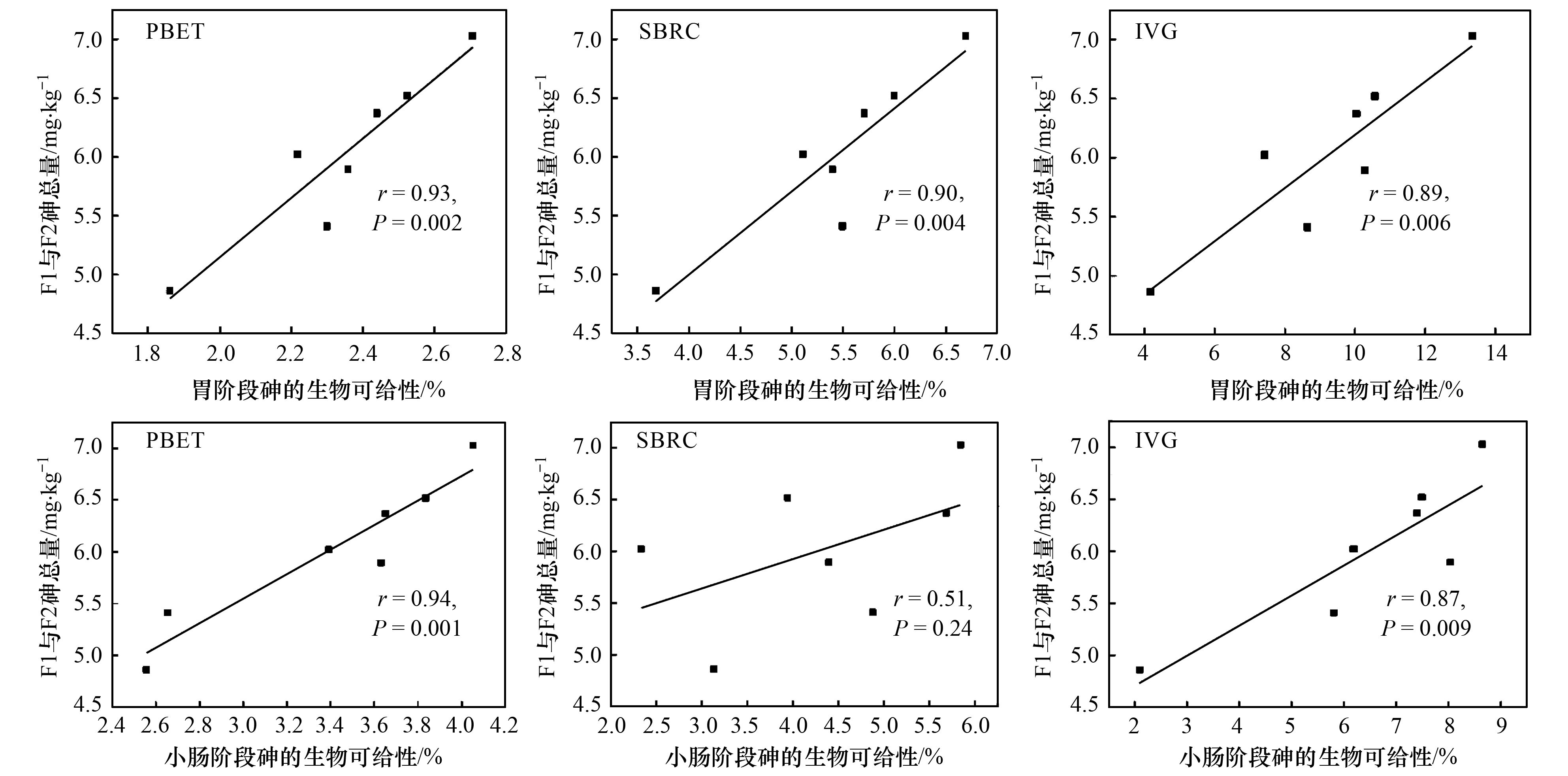
|
图 4 3种实验条件下胃和小肠阶段砷的生物可给性和F1+F2相中砷总量的相关性 Fig. 4 Correlations between total arsenic in F1 and F2 phases and arsenic bioaccessibility in gastric and small intestinal phases by three in vitro methods |
土壤中砷的迁移转化与无定形铁载体有关,一般而言,无定型铁因结晶度较低、比表面积较大且活性高而对砷具有较大的截留性能. 图 5可知,根据PBET、SBRC和IVG这3种in vitro体外模拟法,胃阶段砷的生物可给性和无定型铁结合态砷含量呈负相关关系,分别为r=-0.96(P<0.001)、r=-0.93(P=0.001) 和r=-0.94(P=0.001);小肠阶段砷的生物可给性和无定型结合态砷则表现为只有PBET和IVG法有显著负相关性,相关系数分别为r=-0.95,P=0.001和r=-0.94,P=0.001,而SBRC法则表现为没有相关性.这说明无定型铁结合态砷很难被胃液或者小肠消化液溶出,以及3种铁矿物对砷的稳定化作用较好.施用3种铁矿物后,土壤中无定型铁结合态砷的含量提高,这与土壤无定型铁矿物含量提高有关. Mamindy-Pajany等[36]以不同的起始砷浓度做吸附试验,指出由于赤铁矿比表面积较小,吸附量较低,但砷在赤铁矿上不容易解吸.且施用铁矿物有利于砷在土壤中的形态转化,主要表现为非专型和专性吸附态的含量降低,F3和F4增高[37, 38].一般而言,砷在无定型铁表面覆盖率较高时有利于形成双核双齿表面螯合物,在配位键数较多时则鳌合物较为稳定,且主要通过铁矿物表面羟基进行配体交换时则表现为最为稳定的内圈螯合物[39, 40].因此,在胃液环境pH较低的情况下可能表现较为稳定.进一步研究表明,无定型铁矿物可以经过老化转化为结晶型铁矿物,砷生物可给性的进一步降低与土壤铁矿物相对结晶度[无定型铁矿物/(无定型铁矿物+结晶型铁矿物)]有关,土壤砷生物可给性与无定型铁矿物/(无定型铁矿物+结晶型铁矿物) 的比例呈正相关(R2=0.723,P<0.05),说明铁矿物结晶度提高有利于砷生物可给性的进一步降低[41].这可能与砷同铁矿物的结合从最初快速形成的外圈螯合逐渐转变成内圈螯合物有关.因而,无定型结合态砷则较为稳定,不利于胃液和小肠消化液对砷的溶解.这也与过去一些研究得出的结论相似,添加铁矿物有利于对移动性强的形态砷的捕捉,同时铁矿物的风化老化过程可以更好地固化砷[9, 25, 42].
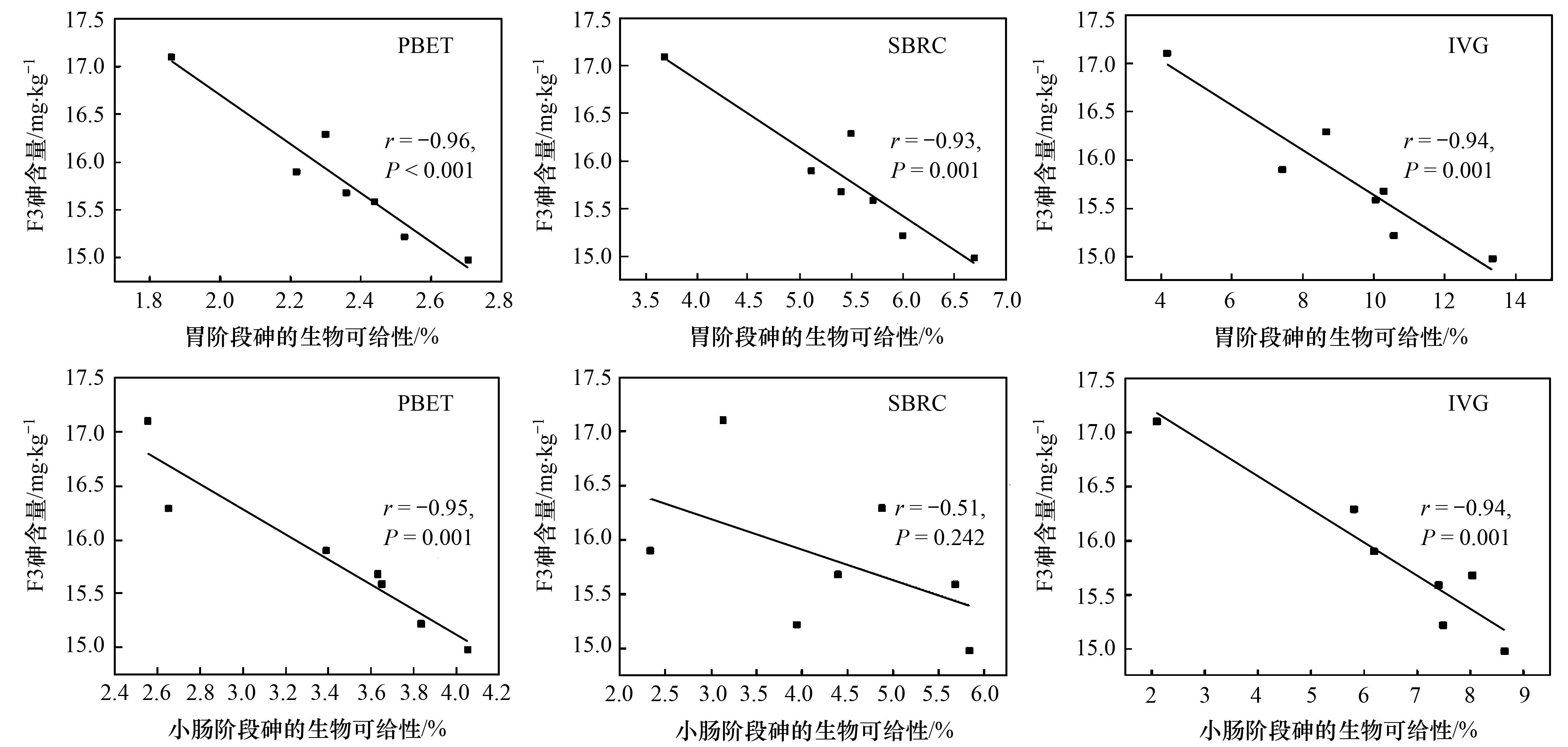
|
图 5 3种实验条件下胃和小肠阶段砷生物可给性和F3砷含量的相关性 Fig. 5 Correlations between the arsenic in F3 phase and arsenic bioaccessibility in gastric and small intestinal phases by three in vitromethods |
(1) 3种in vitro体外模拟方法证实,施用3种铁矿物都有利于降低胃阶段和小肠阶段砷的生物可给性和降低土壤生物有效性.其中,相比于针铁矿和赤铁矿,水铁矿对胃和小肠阶段砷的生物可给性的下降幅度最为显著(P<0.005). SBRC和IVG模拟方法时,主要表现为砷的生物可给性在胃阶段的大于小肠阶段,而PBET法则相反.
(2) 3种in vitro体外模拟方法中,土壤可交换态砷和专属吸附态砷的总量(F1+F2) 与胃阶段砷的生物可给性呈显著正相关关系;可交换态砷和专属吸附态砷的总量(F1+F2) 与小肠阶段砷的生物可给性,只有PBET和IVG法表现为具有显著正相关性.土壤可交换态砷和专属吸附态砷(F1+F2) 对于砷的生物可给性贡献较大,二者占土壤砷总量的质量分数,很大程度上决定砷的生物可给性大小.
(3) 依据PBET和IVG模拟方法,无定型铁结合态砷(F3) 与胃和小肠阶段砷的生物可给性都呈显著负相关关系.施用铁矿物有利于有效态砷和专属吸附态砷向无定型铁结合态转换,因而土壤无定型铁结合态砷含量的提高将有利于降低土壤砷在胃液和小肠消化液的溶解.
| [1] | Liu C P, Yu H Y, Liu C S, et al. Arsenic availability in rice from a mining area:is amorphous iron oxide-bound arsenic a source or sink?[J]. Environmental Pollution, 2015, 199 : 95–101. DOI: 10.1016/j.envpol.2015.01.025 |
| [2] | Zhao F J, Stroud J L, Eagling T, et al. Accumulation, distribution, and speciation of arsenic in wheat grain[J]. Environmental Science & Technology, 2010, 44(14) : 5464–5468. |
| [3] | Mikutta C, Mandaliev P N, Mahler N, et al. Bioaccessibility of arsenic in mining-impacted circumneutral river floodplain soils[J]. Environmental Science & Technology, 2014, 48(22) : 13468–13477. |
| [4] | Yoon Y, Kim S, Chae Y, et al. Evaluation of bioavailable arsenic and remediation performance using a whole-cell bioreporter[J]. Science of the Total Environment, 2016, 547 : 125–131. DOI: 10.1016/j.scitotenv.2015.12.141 |
| [5] | 崔岩山, 陈晓晨. 土壤中镉的生物可给性及其对人体的健康风险评估[J]. 环境科学, 2010, 31(2) : 403–408. Cui Y S, Chen X C. Bioaccessibility of soil cadmium and its health risk assessment[J]. Environment Science, 2010, 31(2) : 403–408. |
| [6] | Li S W, Li J, Li H B, et al. Arsenic bioaccessibility in contaminated soils:coupling in vitro assays with sequential and HNO3 extraction[J]. Journal of Hazardous Materials, 2015, 295 : 145–152. DOI: 10.1016/j.jhazmat.2015.04.011 |
| [7] | Ruby M V, Davis A, Schoof R, et al. Estimation of lead and arsenic bioavailability using a physiologically based extraction test[J]. Environmental Science & Technology, 1996, 30(2) : 422–430. |
| [8] | Rodriguez R, Basta N T. An in vitro gastrointestinal method to estimate bioavailable arsenic in contaminated soils and solid media[J]. Environmental Science & Technology, 1999, 33(4) : 642–649. |
| [9] | Juhasz A L, Weber J, Smith E, et al. Assessment of four commonly employed in vitro arsenic bioaccessibility assays for predicting in vivo relative arsenic bioavailability in contaminated soils[J]. Environmental Science & Technology, 2009, 43(24) : 9487–9494. |
| [10] | Wang Y A, Zeng X B, Lu Y H, et al. Effect of aging on the bioavailability and fractionation of arsenic in soils derived from five parent materials in a red soil region of Southern China[J]. Environmental Pollution, 2015, 207 : 79–87. DOI: 10.1016/j.envpol.2015.08.033 |
| [11] | Zhao F J, Ma Y B, Zhu Y G, et al. Soil contamination in China:current status and mitigation strategies[J]. Environmental Science & Technology, 2015, 49(2) : 750–759. |
| [12] | 王强, 卜锦春, 魏世强, 等. 赤铁矿对砷的吸附解吸及氧化特征[J]. 环境科学学报, 2008, 28(8) : 1612–1617. Wang Q, Bu J C, Wei S Q, et al. Characteristics of isothermal adsorption and desorption, and oxidation of As (Ⅲ) ion on a hematite surface[J]. Acta Scientiae Circumstantiae, 2008, 28(8) : 1612–1617. |
| [13] | Hartley W, Lepp N W. Remediation of arsenic contaminated soils by iron-oxide application, evaluated in terms of plant productivity, arsenic and phytotoxic metal uptake[J]. Science of the Total Environment, 2008, 390(1) : 35–44. DOI: 10.1016/j.scitotenv.2007.09.021 |
| [14] | Suda A, Makino T. Functional effects of manganese and iron oxides on the dynamics of trace elements in soils with a special focus on arsenic and cadmium:a review[J]. Geoderma, 2016, 270 : 68–75. DOI: 10.1016/j.geoderma.2015.12.017 |
| [15] | Jiang S H, Lee J H, Kim D, et al. Differential arsenic mobilization from As-bearing ferrihydrite by iron-respiring Shewanella strains with different arsenic-reducing activities[J]. Environmental Science & Technology, 2013, 47(15) : 8616–8623. |
| [16] | Huang J H, Voegelin A, Pombo S A, et al. Influence of arsenate adsorption to ferrihydrite, goethite, and boehmite on the kinetics of arsenate reduction by Shewanella putrefaciens strain CN-32[J]. Environmental Science & Technology, 2011, 45(18) : 7701–7709. |
| [17] | Christl I, Brechbuühl Y, Graf M, et al. Polymerization of silicate on hematite surfaces and its influence on arsenic sorption[J]. Environmental Science & Technology, 2012, 46(24) : 13235–13243. |
| [18] | 费杨, 阎秀兰, 廖晓勇, 等. 不同水分条件下铁基氧化物对土壤砷的稳定化效应研究[J]. 环境科学学报, 2015, 35(10) : 3252–3260. Fei Y, Yan X L, Liao X Y, et al. Effects of iron-based oxides on arsenic stabilization in soils of different water contents[J]. Acta Scientiae Circumstantiae, 2015, 35(10) : 3252–3260. |
| [19] | 林志灵, 曾希柏, 张杨珠, 等. 人工合成铁、铝矿物和镁铝双金属氧化物对土壤砷的钝化效应[J]. 环境科学学报, 2013, 33(7) : 1953–1959. Lin Z L, Zeng X B, Zhang Y Z, et al. Immobilization effects of synthetic Fe/Al minerals and Mg/Al layered double oxides (Mg/Al-LDO) additions on arsenic (As) in soils[J]. Acta Scientiae Circumstantiae, 2013, 33(7) : 1953–1959. |
| [20] | Juhasz A L, Herde P, Herde C, et al. Predicting arsenic relative bioavailability using multiple in vitro assays:validation of in vivo?in vitro correlations[J]. Environmental Science & Technology, 2015, 49(18) : 11167–11175. |
| [21] | Li H B, Li J, Juhasz A L, et al. Correlation of in vivo relative bioavailability to in vitro bioaccessibility for arsenic in household dust from China and its implication for human exposure assessment[J]. Environmental Science & Technology, 2014, 48(23) : 13652–13659. |
| [22] | Wenzel W W, Kirchbaumer N, Prohaska T, et al. Arsenic fractionation in soils using an improved sequential extraction Procedure[J]. Analytica Chimica Acta, 2001, 436(2) : 309–323. DOI: 10.1016/S0003-2670(01)00924-2 |
| [23] | Legg B A, Zhu M Q, Comolli L R, et al. Determination of the three-dimensional structure of ferrihydrite nanoparticle aggregates[J]. Langmuir, 2014, 30(33) : 9931–9940. DOI: 10.1021/la502128d |
| [24] | Matsumoto S, Kasuga J, Makino T, et al. Evaluation of the effects of application of iron materials on the accumulation and speciation of arsenic in rice grain grown on uncontaminated soil with relatively high levels of arsenic[J]. Environmental and Experimental Botany, 2016, 125 : 42–51. DOI: 10.1016/j.envexpbot.2016.02.002 |
| [25] | Soltis J A, Feinberg J M, Gilbert B, et al. Phase transformation and particle-mediated growth in the formation of hematite from 2-Line ferrihydrite[J]. Crystal Growth & Design, 2016, 16(2) : 922–932. |
| [26] | Cutler W G, El-Kadi A, Hue N V, et al. Iron amendments to reduce bioaccessible arsenic[J]. Journal of Hazardous Materials, 2014, 279 : 554–561. DOI: 10.1016/j.jhazmat.2014.07.043 |
| [27] | Jiang X L, Peng C J, Fu D, et al. Removal of arsenate by ferrihydrite via surface complexation and surface precipitation[J]. Applied Surface Science, 2015, 353 : 1087–1094. DOI: 10.1016/j.apsusc.2015.06.190 |
| [28] | 崔岩山, 陈晓晨, 朱永官. 利用3种in vitro方法比较研究污染土壤中铅、砷生物可给性[J]. 农业环境科学学报, 2008, 27(2) : 414–419. Cui Y S, Chen X C, Zhu Y G. Comparison of three in vitro methods to study the bioaccessibility of soil lead and arsenic[J]. Journal of Agro-Environment Science, 2008, 27(2) : 414–419. |
| [29] | 尹乃毅, 都慧丽, 张震南, 等. 应用SHIME模型研究肠道微生物对土壤中镉、铬、镍生物可给性的影响[J]. 环境科学, 2016, 37(6) : 2353–2358. Yin N Y, Du H L, Zhang Z N, et al. Effect of Human gut microbiota on bioaccessibility of soil Cd, Cr and Ni using SHIME model[J]. Environmental Science, 2016, 37(6) : 2353–2358. |
| [30] | Juhasz A L, Smith E, Nelson C, et al. Variability associated with as in vivo-in vitro correlations when using different bioaccessibility methodologies[J]. Environmental Science & Technology, 2014, 48(19) : 11646–11653. |
| [31] | Liu S, Guo X C, Zhang X X, et al. Impact of iron precipitant on toxicity of arsenic in water:a combined in vivo and in vitro study[J]. Environmental Science & Technology, 2013, 47(7) : 3432–3438. |
| [32] | Ngo L K, Pinch B M, Bennett W W, et al. Assessing the uptake of arsenic and antimony from contaminated soil by radish (Raphanus sativus) using DGT and selective extractions[J]. Environmental Pollution, 2016, 216 : 104–114. DOI: 10.1016/j.envpol.2016.05.027 |
| [33] | Im J, Yang K, Jho E H, et al. Effect of different soil washing solutions on bioavailability of residual arsenic in soils and soil properties[J]. Chemosphere, 2015, 138 : 253–258. DOI: 10.1016/j.chemosphere.2015.06.004 |
| [34] | Okkenhaug G, Zhu Y G, He J, et al. Antimony (Sb) and Arsenic (As) in Sb mining impacted paddy soil from Xikuangshan, China:differences in mechanisms controlling soil sequestration and uptake in Rice[J]. Environmental Science & Technology, 2012, 46(6) : 3155–3162. |
| [35] | Juhasz A L, Smith E, Weber J, et al. In vitro assessment of arsenic bioaccessibility in contaminated (anthropogenic and geogenic) soils[J]. Chemosphere, 2007, 69(1) : 69–78. DOI: 10.1016/j.chemosphere.2007.04.046 |
| [36] | Mamindy-Pajany Y, Hurel C, Marmier N, et al. Arsenic (V) adsorption from aqueous solution onto goethite, hematite, magnetite and zero-valent iron:effects of pH, concentration and reversibility[J]. Desalination, 2011, 281 : 93–99. DOI: 10.1016/j.desal.2011.07.046 |
| [37] | Komárek M, Vaněk A, Ettler V. Chemical stabilization of metals and arsenic in contaminated soils using oxides-a review[J]. Environmental Pollution, 2013, 172 : 9–22. DOI: 10.1016/j.envpol.2012.07.045 |
| [38] | Farrow E M, Wang J M, Burken J G, et al. Reducing arsenic accumulation in rice grain through iron oxide amendment[J]. Ecotoxicology and Environmental Safety, 2015, 118 : 55–61. DOI: 10.1016/j.ecoenv.2015.04.014 |
| [39] | Bolanz R M, Wierzbicka-Wieczorek M, Čaplovi Dč ová M, et al. Structural incorporation of As5+ into hematite[J]. Environmental Science & Technology, 2013, 47(16) : 9140–9147. |
| [40] | Redman A D, Macalady D L, Ahmann D. Natural organic matter affects arsenic speciation and sorption onto hematite[J]. Environmental Science & Technology, 2002, 36(13) : 2889–2896. |
| [41] | Palumbo-Roe B, Wragg J, Cave M. Linking selective chemical extraction of iron oxyhydroxides to arsenic bioaccessibility in soil[J]. Environmental Pollution, 2015, 207 : 256–265. DOI: 10.1016/j.envpol.2015.09.026 |
| [42] | Matsumoto S, Kasuga J, Taiki N, et al. Inhibition of arsenic accumulation in Japanese rice by the application of iron and silicate materials[J]. Catena, 2015, 135 : 328–335. DOI: 10.1016/j.catena.2015.07.004 |
 2017, Vol. 38
2017, Vol. 38


